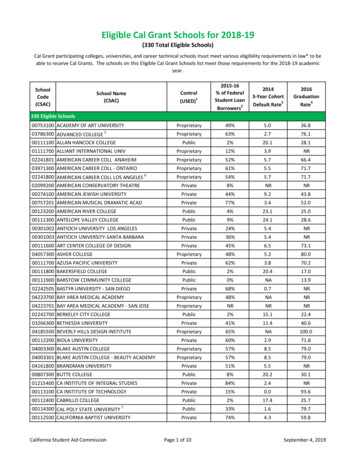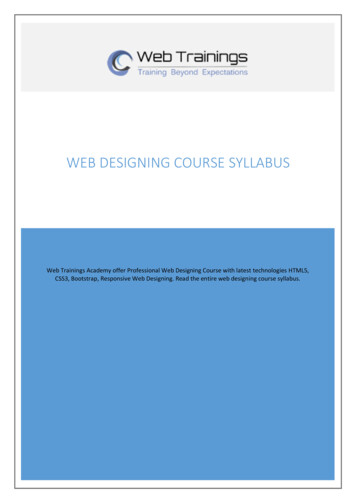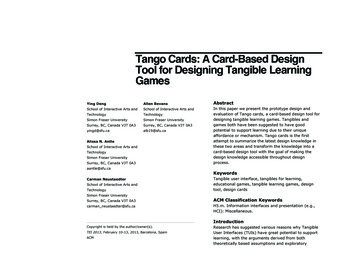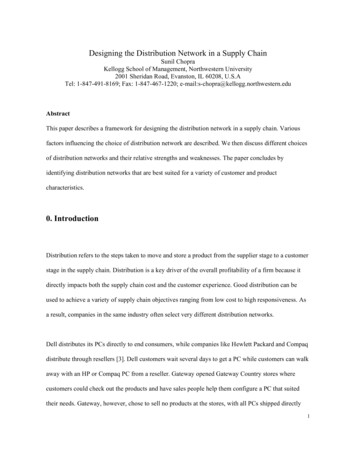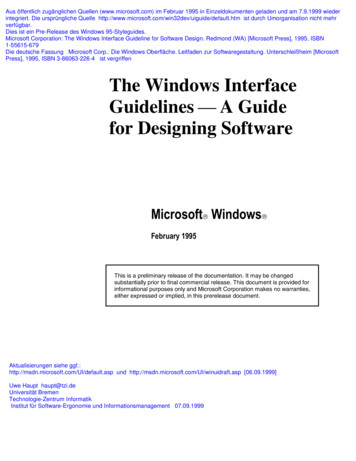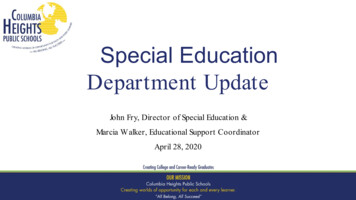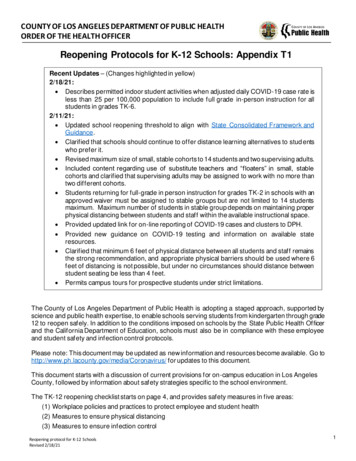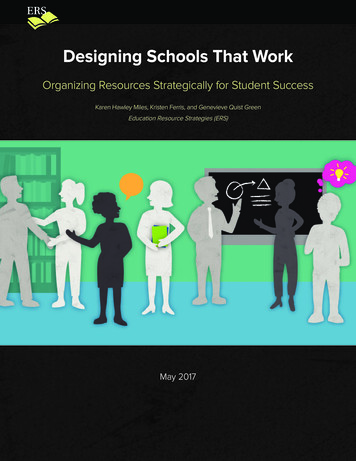
Transcription
Designing Schools That WorkOrganizing Resources Strategically for Student SuccessKaren Hawley Miles, Kristen Ferris, and Genevieve Quist GreenEducation Resource Strategies (ERS)May 20171
Through over a decade of research and practice in the area ofstrategic resource use, Education Resource Strategies (ERS) hasfound that high-performing schools begin with a clear vision ofstudent success and instructional quality, and then deliberatelyorganize resources—people, time, technology, and money—toimplement a coherent set of research-backed strategies to reachthis vision.We call this Strategic School Design.2
MAY 2017Designing Schools That WorkOrganizing Resources Strategically for Student SuccessReinventing Revere High SchoolWhen Dr. Lourenço Garcia assumed leadership of Revere High School in 2012, he tookresponsibility for turning around a school that was ranked in the bottom 20 percent of all schoolsin Massachusetts. Over the next three years, Revere High School went from a Level 3 to a Level 1school in statewide rankings and was the only high school awarded a Gold Medal by the NationalCenter for Urban Transformation, based on its growing achievement scores, high attendance, andhigh graduation rates for every demographic group of students.1 What happened?Revere High School faced challenges that many schools are up against today. Students entered at awide range of proficiency levels, but the school’s structures were standardized: all students movedthrough a seven-period schedule in similar class sizes, teachers delivered new content in class, andstudents were expected to extend and apply work independently after school. Dr. Garcia recognizedthat this traditional school design would need to change if he and his team were going to reset thetrajectory of their high-needs student population.The team began by introducing a new Freshman Academy, with much-reduced class size andflexible student grouping to personalize instruction. Teachers received training to implementflipped classroom instruction, enabling students to exercise greater choice in how they accessed newcontent and spent more time problem solving with their peers and teachers in class. To supportthese changes, the master schedule shifted from traditional periods to longer, 80-minute blocks,which created more time for applied practice and small-group instruction during the school day.Professional Learning Groups now met twice weekly to collaborate around shared curriculum andanalyze student assessment data to determine how to adjust instruction. To respond to socialemotional needs and ensure academic progress toward college, each student was assigned an advisorwho led a weekly advisory program and supported them through all four years. Revere High alsoadded supplemental programs that encourage community service and target additional supportsto students in need. Truly student-centered learning—and the academic growth that comes withit—is increasingly the norm for all students at Revere High School.1
Dr. Garcia started with a clear vision of what student success and instructional quality would looklike at Revere High School, and then deliberately reorganized resources—people, time, technology,and money—to implement a coherent set of research-backed strategies to reach his vision. We callthis Strategic School Design.Revere High School is not an isolated case. In more than a decade of working with urban schooldistricts nationwide, we have seen the transformational impact Strategic School Design can haveon student achievement. This paper explores the research-based common essentials of strategicallydesigned schools and shows the concrete shifts in resource use that are required to make them work.Transforming Schools through Strategic School DesignAs a nation, our vision for success in schools—the way we think about the needs of our students andthe resources we bring to bear—has changed significantly over the past 50 years. We now have clear,rigorous standards designed to ensure that students graduate ready for college and careers, as well asheightened accountability and urgency around helping all students meet them. We have more timelydata on what students need, and on teachers’ skills and expertise. Workforce demands have changed,requiring graduates to be prepared as critiquers of information, rather than simply knowers of facts.Educators have different aspirations. They want opportunities to learn quickly and advance theircareers in measurable ways. They want to work in teams with trusted colleagues. They want highquality instructional materials that are aligned with new standards and to be supported in leveragingthese materials. And they want flexible job arrangements that allow them to better integrate theirwork and personal lives. Finally, new technologies that support learning are advancing every day.Yet despite these significant changes, resource use in schools looks very much the same as it did50 years ago. Students are divided into classrooms of 20 to 30 students, and they study a particularsubject for a set period of time—usually about 50 minutes per day for 180 days—instructed by oneteacher. Teachers have roughly the same set of responsibilities on day one of their job as they will haveon the last day of their career. And they usually work alone to plan and deliver instruction, ratherthan as part of a highly functioning team.Through years of research and practice around school resource use, ERS has found that highperforming, high-growth schools such as Revere are responding to the changing context in educationby using people, time, technology, and money in ways that look significantly different than the statusquo. While there is no one “right way” to organize resources, high-performing schools servinghigh-need students organize around six common design essentials. We argue that to sustain highperformance, a school must eventually address all of the essentials. However, the specific way anyleader chooses to organize staff, time, programs, and students is very different across schools, and itchanges over time to fit unique and evolving student needs, teacher capacity, and lessons learned.These six design essentials are:2
1. Instruction: Uphold rigorous, college- and career-ready standards and use effective curricula,instructional strategies, and assessments to achieve them2. Teacher Collaboration: Organize teachers into expert-led teams focused on the design and delivery ofinstruction, and provide ongoing growth-oriented feedback3. Talent Management: Attract and retain the best teachers and design and assign roles andresponsibilities to match skills to school and student need4. Time and Attention: Match student grouping, learning time, technology, and programs to individualstudent needs5. Whole Child: Ensure that students are deeply known and that more intensive social and emotionalsupports are integrated when necessary6. Growth-Oriented Adult Culture: Grow a collaborative culture where teachers and leaders shareownership of a common instructional vision and student learningFIGURE 1.ool Design for StronghcSSchgiceoolttS rasTIME AGEMENTWHOLECHILDGROWTH-ORIENTED3TUCULTLADURE
At the center of any strategic school design sits a specific model for delivering Instruction. This designessential typically shapes the path for what types of investments are needed across all other aspectsof a school’s broader design. For example, a school’s choice of curriculum, assessment schedule, andshared beliefs about how instruction should be delivered often drive the length of periods or blocks in astudent’s schedule. These choices also influence the amount of time that teaching teams need forcollaboration and how that time needs to be used. Meanwhile, the implementation of high-quality,standards-aligned curriculum in turn depends on the effective implementation of the other designessentials. For example, without expert-led collaboration during which teachers refine lessons oranalyze student work together, even highly effective curricula will be more limited in its effect onstudent learning.An underlying foundation for strategic school design is a Growth-oriented Adult Culture. Researchsuggests that strong adult culture creates the fertile ground for schools to thrive, and that weakbehavioral norms among adults often compromise other school improvement efforts.2 Strong norms,in contrast, set the stage for successful implementation of other design essentials. Strong relational trustbetween staff members, for example, directly supports effective teaching teams: trust makes it easierfor teachers to respectfully disagree with each other and ultimately arrive at an idea or solution that isbetter for students because different perspectives were shared. Trust also sets the stage for productiveconversations between teachers and instructional experts, so that teachers are comfortable discussingareas for growth and the support they need.3The remaining four design essentials in Figure 1—Teacher Collaboration, Talent Management,Time and Attention and Whole Child—define the most critical transformations to the use ofresources in the service of improved student outcomes. We explore these essentials in more detail inthe next section.It is crucial for school leaders to ground their decisions about design essentials in a rich data cycle.In this way, school leaders make each decision from a strong understanding of student need, and canmonitor and adjust through ongoing assessments of student outcomes.School Design TransformationsAs we’ve worked with schools to implement strategic school designs, we’ve learned that they requiresignificant transformation in the way educators and students think about, practice, and engage withlearning—including how the student day is organized to best facilitate learning and the support teachersneed to deliver instruction that is fully aligned to college- and career-ready standards. In this section, weleverage the broader research on effective schools and school improvement and turnaround as well as ourdirect experience working with schools to describe in more detail how we’ve seen resources shift in thecontext of these transformations. We focus on the following four design essentials that require schools to4
make deliberate decisions about how to organize people, time, and money differently (also see appendix,where we’ve laid out the must-haves for each design essential). Teacher Collaboration Talent Management Time and Attention Whole ChildFor each, we provide a case of how a real school has successfully implemented changes to support theessential and seen dramatic results. It is important to note that while the strategies we describe hereare framed at the school level, creating strategic designs at scale also requires complementary strategicsystems in the central office. We begin here by describing school-level transformation because webelieve that only by being clear about what we are trying to achieve in schools can we envision thetypes of systems we need.Teacher CollaborationTraditionally, much of teaching has been practiced in isolation. Teachers most often operate withinthe confines of the four walls of their classrooms, rarely collaborating deeply with peers or expertson instructional planning or delivery. While many teachers may meet in teams, we find that theymuch more rarely view team meetings as a critical part of the work of effective instruction. Yetresearch consistently shows the value of taking on work to plan, deliver, and improve instructioncollaboratively, with one another, and with high-quality, content-specific experts. Not only is it acritical part of the system for professional learning in systems that are getting results,4 but teachersalso like their jobs more when they have the opportunity to work with their peers and learn fromtheir experiences.5 This is especially important when needing to make a big change in practice, suchas that required in many schools with the transition to college- and career-ready standards.We’ve consistently seen that instruction in high-performing schools is not performed by individualteachers, but by teams of educators who all work together to achieve the best possible results fortheir collective students. High-functioning teams result in high-quality daily instruction, and theyfunction as a critical part of job-embedded teacher learning and professional development. In otherwords, they are both about doing the work and getting better at it.Instruction in high-performing schools is not performed by individualteachers, but rather by teams of educators who all work together toachieve the best possible results for their collective students.5
But while learning happens in the context of teacher collaboration, it isn’t sufficient by itself. In a recentstudy of districts that are achieving student and teacher learning results through a deliberate professionallearning strategy, we found that these systems had invested in three common elements:6 C ontent-focused, expert-led collaboration: Organize teachers into teams, led bycontent experts, that have the time, support, and culture of trust and learning tocollaborate on instruction R igorous, comprehensive curricula and assessments: Ensure that all schools haveaccess to rigorous and coherent curricula, assessments, and other instructional resources,aligned to college- and career-ready standards F requent, growth-oriented feedback: Provide regular feedback from content expertsthat helps teachers improve instructional practiceEach of these elements has value on its own, but the systems in the study connected them. Teacherteams engage deeply with the specific curricula and materials they use in the classroom, developand review lesson plans, and analyze assessment results. When teacher leaders observe their peers,they focus on the themes raised during collaborative time and exactly how each teacher presentsthe material, with real-time feedback that can be applied in the classroom and during team time.Instructional experts work across the elements, adapting curricular materials, leading collaborativeplanning, and observing and providing feedback to teachers. Taken together, these elements areconnected to the system’s overall theory of action for how teachers improve and, ultimately, howstudents learn.7 See story on Ashley Park on page 7.Talent ManagementIt’s become an oft-cited truth that having an effective teacher matters most and that having a strongteacher for multiple years in a row makes an even bigger difference.8 Yet we’ve seen that in manyschools, the urgent day-to-day work of implementing instruction, responding to behavior, andmanaging operations crowds out critical efforts to deliberately manage and organize available teachertalent. In most traditional schools, there is only one teaching job. The roles and responsibilities are thesame for a first-year teacher as they are for a highly effective veteran, except that the veterans get morevoice in which courses they teach. And regardless of skill and desire, each teacher teaches the samenumber of students in their daily interaction, and their core responsibility is to independently executethe full cycle of instruction, from data analysis to planning to instructional delivery and assessment.Often, school leaders prioritize minimizing disruption in existing grade and/or subject assignments (i.e.,new teachers are assigned wherever there are openings), individual teacher preference, and seniority (i.e.,more senior teachers get first pick of the best assignments). These practices compromise effective talentmanagement efforts because they fail to optimize a school’s available talent where it is most needed.High-performing schools break from the tradition of a one-size-fits-all teaching job by differentiatingteaching roles and assignments to match individuals’ unique skills and expertise to the needed roles.6
TEACHER COLLABORATION IN ACTION: Ashley ParkA critical component of making the family model work at AshleyPark PreK-8 School in Charlotte-Mecklenburg Schools was buildinghighly effective teaching teams that met regularly to review data,plan instruction, and create student and teacher groupings for upcominglessons in an environment where collaboration had not been the norm. PrincipalTonya Kales took the following actions: She thought carefully about team assignments. Rather than balancing expertiseacross teams in the first year, she deliberately assigned her most effectiveteachers to the upper-grade teams so that she would be able to show quickwins on the state tests in her first year of turnaround and galvanize her community around her reforms. She later rebalanced teams to better spread expertise. She rescheduled students’ four weekly specials periods (e.g., art, music, physical education) into two back-to-back blocks that met only two days per week tocreate two weekly 90-minute blocks of collaborative planning time (CPT) thatwas shared by grade-level teams. One 90-minute block focused on examiningdata from common assessment and individualized student learning needs,while the other provided time for joint lesson planning. To ensure that all teams had an expert facilitator, she restructured the role ofAshley Park’s two instructional coaches to ensure that one was present at eachplanning block to facilitate the meeting and to plan and prepare the content.As with all designs, Principal Kales had to make difficult trade-offs to prioritize themost important strategies. Eliminating daily teacher planning time to allow forlonger blocks of CPT risked creating an unsustainable job for teachers but underscored the importance of using collaborative sessions to accomplish joint planningand data analysis work that teachers would otherwise use individual time to do.The unique schedule she created also required her to move from part-time tofull-time specials staff in some areas to better control when specials teachers werein the building. When they weren’t teaching their subjects, specials teacherspushed into literacy blocks within families.Ultimately, the bet that Principal Kales made on the family model paid off.Teachers now say they feel accountable to each other for success and are able tobring the best thinking of their peers and experts to bear on the challenges theyface. Most importantly, the focus on teaming, together with other aspects of thefamily model strategy at Ashley Park, had a big impact on student results.97
This includes designing teacher leadership roles that give excellent teachers opportunities to share theirexpertise and play a stronger role in schoolwide improvement efforts, and making sure they arerewarded for their additional contribution. Managing teacher talent also means assigning all teachersto grades, subjects, and individual students to deliberately match teacher strengths with student needs.These types of more deliberate roles and assignments can help increase the impact of the most effectiveteachers and help retain them at the school, while also better supporting developing teachers withless-challenging assignments better matched to their growth trajectory.A key part of managing talent to support the empowering curriculum, instruction, and assessment thatsits at the center of any design is organizing well-defined teacher leader roles for vetted content expertswho support collaboration and growth-oriented feedback cycles across teams. In our recent study ofleading-edge systems investing in professional growth with both teacher and student learning results,we found that in every case, schools and districts had organized content expert roles at the school levelto support job-embedded professional learning and effective curriculum implementation.10Developing teacher leadership, and more broadly, designing and assigning roles in ways that matchteacher strengths, is one important aspect of a wider approach that strategic schools take towardmaximizing teaching talent. These efforts also include a deliberate approach to strategic retention,wherein school leaders take deliberate steps to identify, continue to develop, and retain their highestperformers, while also efficiently exiting staff who chronically underperform. This, in turn, is supportedby a clear and fair evaluation process. And all talent efforts are undergirded by a rigorous approach tohiring that treats each new hire as an opportunity to maximize the collective knowledge of the teaching staff.See story on Bancroft Elementary School on page 9.High-performing schools break from the tradition of a one-size-fits-allteaching job by differentiating teaching roles and assignments tomatch individuals’ unique skills and expertise to the needed roles.8
TALENT MANAGEMENT IN ACTION: Bancroft Elementary SchoolBancroft Elementary School is a Title I school in the DC PublicSchools where more than half of students are English languagelearners and a significant majority qualify for free or reduced lunch.Seeking to better align PD to school needs and develop teachers internally, Bancroftjoined an innovative DCPS initiative called the Teacher Leadership Innovation pilot(TLI) in 2014. As part of TLI, six of Bancroft’s 49 teachers became teacher leaders,spending 50 percent of their time observing and coaching teachers and facilitatingweekly 90-minute instructional seminars.The TLI program increased how frequently teachers received observation andfeedback from three to five times a year to nearly 20. Teacher leaders observe everyteacher at least every two weeks for 20 minutes, followed by a 45-minute debrief.Having more leaders also allows Bancroft to differentiate support for teachers andmatch teachers to coaches based on data.This frequency of feedback from fellow teachers improved the culture of feedback atBancroft. As one teacher described, “Before, teachers weren’t really receptive tofeedback and siloed themselves. Now we have teachers that are willing to share theirbest practices and be more vulnerable. I think it’s making teachers more collaborative.”The combination of the coaching and seminars has also led to improved instructionand teacher retention. The principal reports that instructional rigor has increased andclassroom management has improved. The support, as well as the opportunity forleadership, also helps to retain talented teachers. In the past year, only four teachersleft Bancroft, instead of the usual 10 to 14.Bancroft’s principal made strategic choices to maximize the impact of the teacherleadership program. He has structured each of the teacher leader roles asinterventionists, rather than having two teacher leaders share one homeroomclass, to minimize the disruption for students and provide the leaders with moreflexibility in their schedules to conduct observations.Due to the success of schools like Bancroft Elementary, DCPS expanded its teacherleadership pilot as part of a districtwide adult learning program called LEAP. Allteachers can now receive frequent coaching, through a combination of teacherleaders, instructional coaches, and assistant principals. For its leaders, the districtprovides support at scale with a two-week summer intensive plus quarterly full-dayworkshops. Potential leaders take a centrally administered exam to assess contentexpertise, and principals look at the results when hiring leaders for their buildings.Principals also receive guidance from the district in building their master schedulesaround the program.9
Time and AttentionOne of the most difficult parts of a teacher’s job is differentiating instruction among studentswith diverse learning needs and helping them access rigorous, grade-level content while alsomeeting them where them enter. Further, research suggests that ideally, teachers wouldn’t stop atdifferentiating on the basis of what students know, but would also adapt tasks to allow for greaterstudent agency and choice, fostering the type of deeper learning associated with better outcomes.11In traditional, one-teacher classroom settings that offer only standardized uses of time and staff,this is a truly daunting task.As discussed above, high-performing schools begin addressing the challenge of personalizing programtime and attention through expert-led collaborative work where teachers can think through how tocreate the right tasks that are rigorous and differentiated, and speak to students’ interests. As withany design essential, instruction also plays a key role here in offering the right sorts of tasks andassessments as well as clarifying the vision around what good personalized teaching and learning lookslike. Critically, high-performing schools also build schoolwide systems that support more targeted andflexible use of the resources that support differentiated and individualized instruction: people, time,programs, and technology. This means tailoring schedules, class sizes, teacher loads, and technology useto the specific needs of individual students, content areas, and lesson types. For example, writingteachers might have student loads of 60 versus the school average of 90 so they can provide meaningfuland applicable feedback several times a week. Students studying key subjects in important transitiongrades, such as Algebra I in 9th grade, might be given additional time in the master schedule, smallergroup sizes, and/or access to the school’s most expert teachers. Biology students may have extendedtime blocks each week to enable hands-on lab work.In addition to organizing to ensure that learning resources are flexible across different students, highperforming schools also ensure that resources are flexible for any individual student over time,allowing constant adjustment to each student’s changing needs. For example, students placed into theextra reading block might exit at midyear or sooner based on performance, just as new students mightenter. Or schools might build in flexible blocks of time during the day to allow resources to vary morefrequently, such as tutoring or intervention/enrichment blocks. In some of the most sophisticatedapproaches, the entire day might be organized flexibly, with students proceeding at their own pacethrough a series of competencies and receiving ongoing support tailored to their individual needs. Thissort of approach is often facilitated through technology. See story on Adams Elementary School on page 11.High-performing schools also ensure that resources are flexible forany individual student over time, allowing constant adjustment toeach student’s changing needs.10
TIME AND ATTENTION IN ACTION: Adams Elementary SchoolAdams Elementary in the Oklahoma City Public Schools is pilotingpersonalized learning to improve student engagement and success.Sixth-grade students struggled not only academically, but also withattendance and suspension, so the team of two 6th-grade teachers decided to rethinktheir approach.The teachers started with a vision, “multisensory instructional-based learning,” anddeveloped it with the help of numerous partnerships into a robust pilot program thatis seeing results. In year two of the pilot, they further personalized their curriculumthrough the Summit Learning program. Summit, a non-profit, provides a free onlinelearning platform, standards-based curriculum, and professional development tocohorts of schools seeking to implement project-based personalized learning.Students spend the bulk of their day working on projects in groups, interspersedwith personalized learning time on computers. Teachers therefore take on the roleof facilitators. Teachers meet with each student for 15 minutes over the course of theweek to set goals. The teachers then monitor student progress through data thatthe Summit program compiles and decide when to reteach lessons or what smallgroups to work with.To see success with personalized learning, the Adams Elementary teachers changedhow they used their time and resources. Teachers continually modify the studentschedule to fit learning needs and students gained additional time to learn at theirown pace through optional Saturday schools, extended before- and after-schoolhours, and sessions during vacation weeks. Sixth-grade teachers also received theirown collaborative planning time (previously it was combined with 5th grade). Inaddition, the teachers had monthly data and coaching calls with Summit Learning.With grants, partnerships, and strategic use of Title I dollars, the school purchasedcomputers for a 1:1 student-technology ratio in grade six and installed wifithroughout the building.While only in its second year, the program is already showing success, and theschool is planning to expand personalized learning to 5th grade. The 6th gradersare making gains on their interim assessments, attendance in 6th grade is thehighest in the school, and disciplinary referrals are down. Most importantly, theprincipal says she sees “such a turnaround in how kids speak about learning. Theyask each other, ‘Have you passed a content assessment?’ and encourage those whotake the assessment again. None of them used to talk about learning before, andnow some of them are.”11
WHOLE CHILD IN ACTION: The Generation Schools NetworkThe Generation Schools Network is a nationally recognized non-profitthat runs two schools that have high populations of minority andeconomically disadvantaged students, Brooklyn Generation School (BGS)and West Generation Academy. In 2007, when BGS opened as part of a districtwideturnaround strategy, only 20 percent of its incoming 9th graders entered at or abovegrade level. BGS leadership placed great emphasis on cultivating personal relationships among students and teachers as a part of their strategy to catch students up totheir peers. BGS reduced core class size from approximately 35 to 18–22 by building aschedule in which most teachers teach core classes, which all meet in the morning.Then student
Education Resource Strategies (ERS) Designing Schools That Work May 2017. 2 Through over a decade of research and practice in the area of strategic resource use, Education Resource Strategies (ERS) has found
